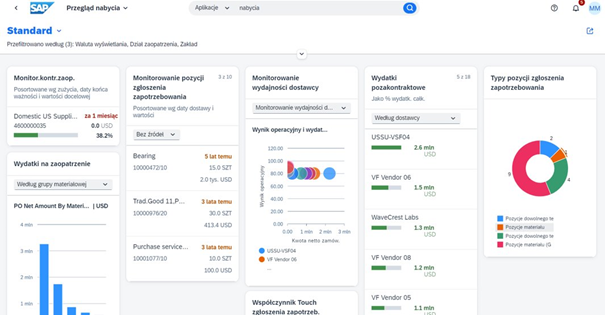Implementation of the SAP system using the greenfield method (i.e. “from scratch") is associated with starting a project from a blank page: modeling target processes in a dedicated tool, discussing individual steps, printouts, reports and collecting all findings in a comprehensive document constituting the concept of implementation. This process requires time and a lot of involvement of key business people.
It looks a bit different for rollout projects. Here, the corporation provides a model concept, a model system on which the available processes can be run, and the target scope of implementation is determined during the Fit & Gap analysis. On the one hand, this approach shortens the time needed to analyze the requirements, and on the other hand, thanks to the availability of the system, it allows the project team to become familiar with the real processes that all users will work on after the implementation from the very beginning.
Now, thanks to SAP Best Practices, the approach used so far in rollouts can also be transferred to greenfield projects. This was reflected in the latest SAP implementation methodology – SAP Activate.
A few words about SAP Activate
SAP Activate is an implementation methodology that includes elements of agile methodologies. It comprises six phases:
Discover – in this phase, the main emphasis is put on getting to know the system and its functionality as well as determining how the new system can support the company’s business. The ability to use demo systems is extremely important for this phase.
Prepare – In this phase, detailed project planning and kick-off take place. The schedules are finalized, the project team is appointed, and the phase ends with a kick-off meeting officially launching the project.
Explore – The main activity of this phase is the Fit-to-Standard analysis aimed at confirming that the processes included in the scope of the project meet the business requirements, and identifying the necessary changes in relation to the standard configuration.
Realize – The goal of this phase is to incrementally deliver the target solution as agreed upon in the Explore phase. The project team migrates the data, tests the solution and prepares the go-live procedure.
Deploy – In this phase, the production system on which the business begins its daily work is prepared and launched (according to the go-live procedure).
Run – The main activity of this phase is further optimization and automation of the solution so that it best supports the dynamically developing business.

SAP Activate methodology – phases
What are SAP Best Practices?
SAP Best Practices are a collection of several hundred pre-configured business processes available for both the public and private versions of S/4HANA Cloud. These processes have been prepared by SAP based on the experience gained during implementations for over 440,000 customers in 180 different industries. As a result, customers gain access to the best practices regarding, for example, the organization of the supply process, production or sale from the warehouse. For each process, SAP provides its description, a BPMN diagram, a test scenario, and for some even an online tutorial. The best practices included in the processes can help streamline existing business processes to work optimally.
A demo system
Already in the Discover phase, i.e. before making a decision on implementation, a potential customer can use a demo system configured in accordance with SAP Best Practices. This applies to both a public and private cloud, depending on the customer’s preferences and the scope of implementation. As a result, already at this stage, project team members can familiarize themselves with the standard process flow (e.g., sales from the warehouse or made to order production), the user interface or built-in reports. SAP licenses for demo systems are provided free of charge, and the customer only bears the cost of the infrastructure (in the case of the Public Cloud edition, 14-day access to the trial system is completely free).

Sample user interface of the free SAP demo systemAccess to all of the above tools allows us to treat a greenfield implementation as a rollout, where not corporate processes, but SAP Best Practices processes are a template. It is in this context that one of the tasks of the Explore phase, i.e. the Fit-to-Standard analysis, is carried out.
Fit-to-Standard analysis
In accordance with the SAP Activate methodology, Fit-to-Standard workshops are carried out on a dedicated Starter system (for SAP S/4HANA Cloud Public Edition implementations) or on a development system (for SAP S/4HANA Cloud Private Edition implementations, On-prem). During the workshop, the project team discusses the same processes and functionalities that they became familiar with during the Discover phase, except that every screen, report, printout or interface is thoroughly discussed during the workshop, and all necessary customizations are written down and included in the backlog.
This process is largely similar to the Fit & Gap analysis known from rollout projects, i.e. verification of the corporate template in terms of matches and differences in relation to the needs of the new entity. During this analysis, the project team goes through all the processes within the scope of the project (including printouts, interfaces, reports) and verifies whether their shape can be used for the new entity 1:1 or requires changes and adjustments. Or maybe it is necessary to implement a completely new process that is not included in the template because it does not exist in the parent company?
Exactly the same steps are assumed in the Fit-to-Standard analysis, except that the template here is not the parent company’s corporate template, but a set of several hundred SAP Best Practices business processes. It is worth noting that SAP Best Practices cover practically all operations of the company, including such business lines as sales, procurement, finance, production, supply chain, service, maintenance and R&D. The customer’s project team can use the documentation prepared by the manufacturer (unfortunately, some of the documents are only in English), which facilitates the execution of the process in the system. Together with experienced consultants, the team can determine to what extent standard processes can be used by the business. And here, as in the rollout project, one of the biggest implementation challenges appears.
A change of mindset
The use of the template eliminates the need to focus on designing standard processes. All energy can be spent on identifying the functions and processes that provide a competitive advantage for the company, and deciding how best to reflect these elements in the system. However, this means that the people responsible or executing standard processes will have to adapt to the new guidelines, perhaps adopt a different point of view, and sometimes even change the scope of their duties. This makes it sometimes more difficult to change the course of a process that has existed in a company for many years than to implement a company-specific process in the system. Fears of adapting to a standard where possible overshadow the real need to create new, dedicated solutions that support non-standard situations.
Since any change, even a small one, arouses reluctance and apprehension at first instinct, proper communication is especially important. From the Discover phase onward, the SAP Activate methodology includes elements of OCM (Organizational Change Management) highlighting the steps that need to be taken in order for the organization to be able to fully absorb the new solution. This is particularly important during the Fit-to-Standard analysis, where a good understanding of the type and nature of the changes resulting from the introduction of standard processes is key to developing an optimal solution design and successfully implementing the subsequent project phases. By removing both communication and organizational barriers and creating a good atmosphere around the project, the OCM team provides the right conditions for the implementation project to be successful.

